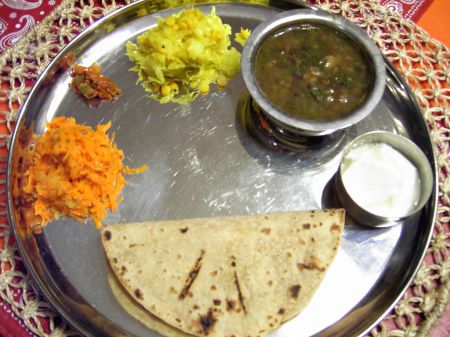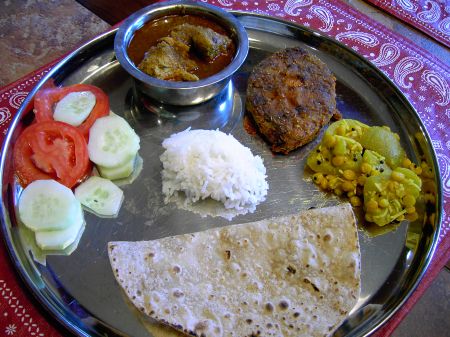Continuing on the food trail of Maharashtra, today we have Meera of Enjoy Indian Food share with us home-cooked traditional Maharastrian thalis. Meera’s blog is home to many authentic home-style recipes of Indian regional cuisines, be it Maharashtrian, Gujarati, Malvani, South Canara, Rajasthani, Punjabi or Goan. Whenever I visit her blog I always have this feeling of ‘India on my plate” which I find truly inspiring. Today, Meera shares with us traditional Maharashtrian thalis (veg & non-veg) Thank you, Meera for sharing with us an indepth article on traditional Maharashtrian food, both vegetarian and non-vegetarian thalis. Dear readers, please give a warm welcome to Meera. 🙂
~Sailaja
My Family Meal – Maharashtrian
Sailaja of Sailu’s Kitchen & Taste of India has welcomed a novice blogger like me to write an article on traditional Maharashtrian Thali – my family way. Frankly, I had jitters as I am neither a wordsmith nor a food expert. The high standards set by Sailu herself, along with Nupur of One Hot Stove with her beautiful guest post on Maharastrian food made me quite nervous. But with Sailu’s gentle encouragement, I have decided to write this article.
My family is blessed to have a potpourri of different cultures of India. But since this is the Maharashtra series, I have kept the flavor Maharashtrian. The traditional family meal that I am talking about today is “A traditional Maharashtrian meal” and not “The Traditional Maharashtrian meal”. There are many communities which call Maharashtra their home so each and every meal could be an individual topic of research.
I come from a family with a unique blend of two different Maharashtrian communities – one strictly vegetarian and the other strictly seafood lovers. So when Sailu told me to write about our family’s traditional home meals, I decided to divide this article into two parts. Family Thali – Vegetarian & Non-Vegetarian.
1) Vegetarian Thali – (Jevanache Paan)
A festive Maharashtrian meal can be very elaborate. It contains arrays of different vegetables, pulses, sweets and salads. The order in which the thali is presented is also given utmost importance. When arranging a meal, consider thali as a clock, the number 12 position is salt, to its left is a lemon wedge, and then to the left are array of chutneys, pickles (Lonache) and salads (koshimbeers). To the right side of salt are different vegetables like paatal bhaji (vegetable curry), paale bhaji (leafy greens), suki bhaaji (dry stir fry), usal (sprouts), Amti (daals). Cooked white rice is molded in a small mound called bhatachi mood, with a bright yellow plain daal (varan) annointed with a dollop of clarified butter (toop).
There may be another variety of spicy rice dishes like Masale bhat. There could be two three types of chutneys typically a green chutney and panchamrit – a tamarind/jaggery & nuts based chutney. Koshimbeer – raw salads generally paired with roasted peanut powder (daanyache koot) and flavored with either lemon juice or a plain yogurt based koshimbeer. Mattha – a spiced buttermilk is always served with such an elaborate meal along with a variety of sweets like jalebi, shrikhand, modak, puranpoli etc. There could also be some fried crispies like bhuji (fritters), kothimbeer vadi or papad or saandge & Kurdaya.
If the meal is for any religious festivities, onions and garlic are avoided. I have eaten elaborate meals during weddings and big family functions. There are some other mandatory rituals before actually eating the meal as well. You need to pay your respects to food which is considered poornabramha – God. My grandfather used to recite the following Marathi prayer:
“Vadani kawal gheta, naam ghya shrihariche
Sahaj hawan hote, naam gheta fookache
Jeevan Kari Jeevitva, Anna hey poornabramha
Udar Bharan Nohe, Jaanije Yadnya karma”
I have given the meaning with the help of my mother.
Meaning – Partaking food is not mere satiating hunger, it is in fact a yagya. The food is Brahma incarnate that gives life its living force.
The meal always ends with a simple thanksgiving prayer: “Annadaata Sukhi Bhav!”
With changing times it was impossible to put together the entire spread for every day meals. Due to work pressure, time constraints, calorie/diet needs, smaller families, working moms, the meals were reduced but like all mothers, my mom tried to keep the essence of the traditional thali alive in our daily meals. A daily family meal at my home would consist of :
1) Fulke – Wheat flour flatbreads roasted on the flame – We call it poLya.
2) Bhaaji – (Any one or the combo of the following)
a) Stir Fry/Suki Bhaaji – Mom always paired the vetgetables with sprouts. Green beans + Kala Vatana Sprouts, Green bean + Matki, Tondli + Chana, Yard long beans + Kala Vatana sprouts, Cabbage + Chana daal, Snake gourd + Chana daal or Field beans, Knolkol + Moong Daal.
or
b) Paalebhaji/Leafy Greens- Every other day, mom tried to include leafy greens like alu/taro leaves, paalak/spinach, lal math/amaranth, methi/fenugreek, shepu/dill leaves just to name a few.
or
c) Usal – sprouts were the part of daily meal either paired with the bhaji or stir fries by themselves called usals.
3) Daal or curry – Mom served one type of daal daily. It could be plain daal – Varan or numerous versions of daal including Amti, Fodniche Varan, Ambat Varan, Kandyachi Amti, Jiryache Varan, Daal Vanga, Methi Daal, Lasnichi Daal to name just a few. or she paired daal with leafy greens or vegetables to save the time and still provided the best of the both.
4) Koshimbeer – the raw salads either shredded, diced or chopped flavored with peanuts and lemon or yogurt as mentioned above.
5) Bhaat – Plain boiled rice
6) Dahi – The dinner would almost always end with simple dahi-bhat (curd rice) without any tempering with a small individual cup of homemade dahi set in every thali.
Sweet dishes and deep fried savories were reserved only for special days. Homemade Ghee/Toop was kept on the table to serve ourselves sparingly. The essence of this vegetarian meal was Goda Masala.
My family Vegetarian thali
Recipe for Mom’s Masoor – Paalak Amti (Spinach & Lentil Curry)
Ingredients:
1 ½ cups Masoor sprouts
1 cup spinach, roughly shredded
1 small potato, peeled, diced
1 small onion, chopped
2 cloves garlic, minced
1†ginger, smashed but still whole piece
1 small tomato, chopped
½ tsp mustard seeds
¼ tsp asafetida
2 green chilies, slit
2 sprigs curry leaves
1 tbsp jaggery
Salt to taste
3-4 kokums, rinsed
2 tsp goda masala
½ tsp turmeric powder
1 tsbp coconut (optional)
1 tbsp cilantro/coriander leaves, chopped
Method:
1. Pressure cook all the ingredients till curry leaves adding 3 cups water.
2. Pour the mixture in a big saucepan. Add water to get the desired consistency.
3. Add all the remaining ingredients.
4. Bring to boil. Let it simmer for 15 minutes on a low flame till all the flavors are incorporated.
5. Serve as a soup or with rice.
Note: You can add more water as the amti is boiling. But adjust salt accordingly.
2) Non-vegetarian Thali – ( Sunday Special)
Six days out of seven were vegetarian food, so Sunday was reserved for the non-vegetarian bonanza. We would really look forward to the Sunday special non-veg meal. Traditionally, my family ate only seafood but somewhere the last generation also started eating eggs, chicken and mutton. My mom learnt to cook meat only after her marriage. A typical Sunday meal would consist of :
1) Curry – Chicken or Mutton or Seafood like Pomfret Curry (baajarachi Amti)
2) Fried Seafood – Tallela Baajaar/Fried fish
3) Soul Kadhi/Footi Kadhi – A cooling drink which is also considered as a digestive aid.
4) Plain rice
5) PoLya
6) Koshimbeer – mostly sliced cucumbers, onions, tomatoes & lemon wedges
7) Paaley bhaaji – some leafy greens stir fry
Some times a rare indulgence of meetha paan as an after-meal bonus was allowed.
My family Non-Vegetarian thali
Recipe for Mom’s Fried Fish
Ingredients:
4 fish steaks (like pomfret, king fish etc)
½ tsp turmeric powder
Salt to taste
1 tsp chili powder
¼ tsp asafetida
Coarse rice powder or semolina to dredge
Oil for shallow frying
Method:
1. Cut, clean and rinse fish steaks.
2. Apply salt, turmeric powder, chili powder & asafetida.
3. Heat oil in a frying pan.
4. Dredge the steaks in semolina or rice powder
5. Gently slide the steaks in hot oil.
6. Fry till crispy on both sides.
Next week, you can look forward to my second article on traditional snacks and sweets of Maharashtra.
Article, Recipes & Images – Meera
Earlier on Indian Food Trail ~ Maharastra
A Simple Summer Meal – by Nupur





















